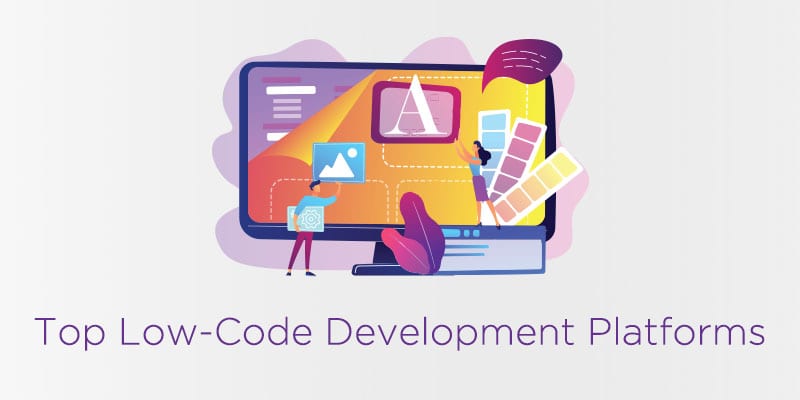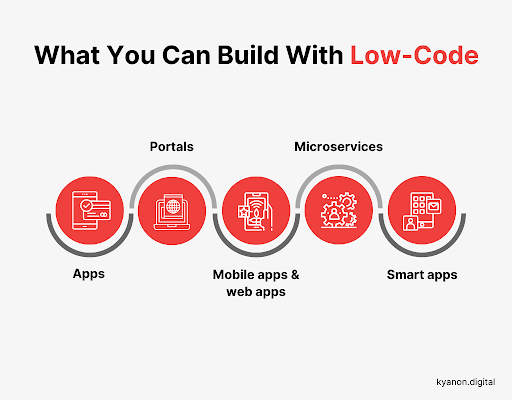Best Info On Choosing Low-Code Platform Sites
Best Info On Choosing Low-Code Platform Sites
Blog Article
Advantages Of Low-Code Application Development In Terms Of Integration Capabilities
Low-code development is a great method of creating applications that are able to seamlessly integrate different platforms and services. Here are the benefits of APIs and connectors that are pre-built:
A Wide Variety of Connectors: Low-code platforms generally come with a huge collection of pre-built connectors for common enterprise systems (e.g. ERP CRM, databases, as well as cloud-based services). It makes it easier to integrate these systems.
API Integration: A lot of platforms provide out-of-the-box API integration capabilities. This lets developers easily connect with external data and services.
Easy to make use of
Drag-and-Drop Integration integration tasks can usually be accomplished using drag-and-drop interfaces, making it accessible to both developers and non-developers to design complex integrations without writing extensive code.
Visual Workflow builders Visual Workflow Builders: These tools can be utilized to design workflows, data flow, and integrations. They help with understanding and establishing them more intuitively.
Standardized Integration Methods:
SOAP and RESTful Services Support for web services protocols like SOAP and REST allows straightforward integration with a wide array of external software and systems.
OData and other Standards Standardization such as OData provides the easy access and manipulation of data on different platforms and programs.
Real-Time Data Synchronization:
Real-Time Integrations: Lowcode platforms are able to handle data synchronization at a real-time rate between the system and applications to ensure that data is updated and uniform across an organisation.
Event-Driven architecture: Certain platforms support event driven architectures. This lets applications respond to events in real time and is crucial for dynamic and interactive apps.
Legacy System Integration:
Low-code platforms provide many tools to connect with existing systems. They allow organizations to modernize IT without re-designing their current systems.
Data Migration Tools: Built-in data migration tools facilitate the transfer of data from old systems to new software built using low-code platforms.
Integration of Third-Party Services:
Cloud Services Integration: The seamless integration of cloud services like AWS Azure, Google Cloud facilitates the easy deployment and scaling up of applications.
Integration of Business Applications Lowcode platforms can be used to integrate different business applications including Salesforce, SAP, Microsoft Dynamics etc., creating a cohesive workflow between different business functions.
Simplified Data Management:
Unified Data Models: Some low-code platforms provide unification of data models that make data management easier and integration between different systems.
Data connectors: Preconfigured data connectors provide easy access and manipulation to data from a variety of sources.
Security and Compliance:
Low-code integration platforms comply with security standards to protect the data during transport or in rest.
Compliance Features - These platforms come with features that make sure that the integrations are in compliance with regulatory standards.
Extensibility:
Custom Codes and Scripts. For more complicated requirements for integration, low-code platforms usually allows the use of custom scripts and code. This provides flexibility without compromising user convenience.
Plug-in Ecosystems: A plugin ecosystem can be used to expand the integration capability and permit users to add additional functionalities when needed.
Overall, low-code development platforms offer powerful integration capabilities that make them an excellent device for developing interconnected and efficient applications. They simplify the process of connecting disparate systems, enhance data flow and allow companies to take advantage of innovative technologies while also leveraging existing ones. Follow the best go here about Low-code Platform for application development for website advice including app modernization, rad development, mobile app development platforms, low code platforms, build a docker container, app modernisation, application development platforms, rapid applications, cross platform app development, rapid applications and more.
Scalability And Flexibility Are Two Advantages Of Low-Code Application Development
Low-code development can bring many benefits in regards to scalability and flexibility, which is crucial to building applications that are able to grow and adapt with changing business requirements. These are the most significant advantages:
Cloud-Based Platforms: A large number of platforms for low-code are cloud-based. They allow applications to grow quickly and smoothly using the cloud infrastructure. This lets businesses handle the increased demand without worrying about managing servers.
Auto-Scaling Features: Auto-scaling functions built-in can automatically adjust resources based on the demand, ensuring a constant performance during peak times without any manual intervention.
Flexible Architecture:
Modular design Low-code platforms are a excellent way to promote modular applications. This allows components to be developed independently as well as tested, sized, etc. This modularity is a great way to enhance flexibility. It is also easy to upgrade and expand components of an application without having the entire application affected.
Microservices integration: The support offered by the microservices architecture enables applications to be developed as a collection loosely linked services. This enhances both capacity and flexibility.
Customizable solutions:
Flexibility : Low-code platforms allow developers to expand functionality beyond the standard features. This guarantees that specific business requirements can be met without any limitations.
Third-Party Integrations: Companies can add additional functionality and features into their applications through APIs and third-party providers.
Agile Development and deployment
Continuous delivery and deployment Low-code platforms work with agile methodologies and facilitate continuous integration and delivery (CI/CD). This allows for rapid deployment of updates and new features, which allows applications to grow quickly as a result of the feedback of users and changes in the market.
Iterative Development: This low-code model permits applications to be improved and scaled incrementally which lowers risk and allows for a more controlled expansion.
Resource Optimization
Effective Resource management: Low-code platform tools help optimize resource use by monitoring and regulating the performance of software. It ensures that resources are used efficiently and scaled up or back down according to the actual needs.
Load Balancing: Integrated load balancing functions distribute the workload equally across servers, improving the ability of the application to handle large volumes of traffic while ensuring the same performance.
Global Reach
Multi-Region Implementation: Low-code platforms can be deployed across many geographic regions. This allows companies to provide users with low latency access worldwide. This is essential, especially for applications that serve global users.
Localization Support for localization built in, which allows applications to be adaptable to different languages or regional requirements. This allows for greater flexibility in different markets.
Updates and maintenance
Simplified Maintenance : Low-code applications are modular and visual. This makes maintenance easier. This lets updates and bug fixes be made quickly, with no lengthy downtime.
Version Control Systems for Controlling Versions can help you manage updates, rollbacks and changes. They make sure that they are released in a safe manner and that previous versions can be restored if needed.
Cost Efficiency:
Low-code platforms cut down on development costs by reducing the need for extensive code. They also make it possible to scale applications with no need for a significant expenditure or effort.
Pay-as-you-go models A lot of platforms for low-code provide flexible pricing options, like pay-as-you go model that aligns the cost and usage to the actual growth.
In general, low-code app developers provide a high degree of flexibility and scalability that allows businesses to quickly build adaptable and flexible applications. These platforms permit quick adaption to changing needs, efficient resource usage, and continuous improvement. This ensures that applications can evolve with the needs of the business. Follow the best Enterprise application development with Low-code Platform blog for website recommendations including rad application development, stored sql procedures, azure sql server, application modernization, rapid application design, cross platform app dev, rapid action development, azure sql databases, push notifications android, push notifications and more.
The Benefits Of Low-Code Programming For Both Community And Vendor
Low-code applications development platforms are a great method to gain support from the vendor as well as community participation. Both of these factors are essential to ensure the success of your implementation as well as ongoing maintenance of the app. These are the main benefits: Support
Comprehensive Technical Support:
Support Teams with Dedicated Support Many low-code platforms offer dedicated support teams that can help with technical issues, problem-solving, and guidance. This ensures that any problems are quickly resolved.
Certain vendors provide 24/7 support. This is especially helpful to global businesses with different time zones.
Training and Onboarding
Vendors often provide structured programs for users including tutorials or webinars. They may also provide training courses for certification.
Customized Onboarding : Many vendors offer customized onboarding services that help new customers to implement the platform and customize it to meet their individual requirements.
Regular updates and enhancements
Continuous Improvement: Lowcode platform vendors usually regularly release updates that contain new features, performance enhancements as well as security patches. This is a way to ensure that the platform remains up-to date and secure.
Feedback Integration: A lot of vendors integrate user feedback into their development cycles. This ensures that the platform can adapt to the ever-changing demands and needs of its users.
Comprehensive Documentation:
Detailled Documentation: Comprehensive and well-organized documentation is usually available, covering everything from the basics of use to advanced customization, which helps users to find solutions independently.
API References API documentation can aid developers build and integrate apps using the Low-Code platform.
Professional and Consulting Services
Expert Consulting: Many vendors provide consulting services for architectural planning, strategic planning, and complex implementations. This allows users maximize their capabilities of the platform.
Custom Development Services A few vendors offer custom development services to create specific integrations and features that are not available as standard.
Community Support for the Community
Active User Community:
Discussion boards and forums Discussion boards and forums: Many low-code platforms have vibrant online communities where users can inquire about issues, exchange ideas and collaborate on best practice.
User Groups and Meetings Both local and virtual groups of users and meetups give you the chance to study about, network, and share experiences with other users.
Knowledge sharing and collaboration:
Community-Contributed Resources: Users often share templates, modules, and extensions that they have developed, which can be reused or adapted by others, accelerating development and innovation.
Crowdsourced Problem-Solving: The collective experience and knowledge of a community can be a valuable source to solve problems and discover creative solutions to difficult problems.
Development and learning:
Community-led training: Many communities offer workshops, webinars and training sessions that are led by experienced users.
Online Tutorials and Courses: Community members often develop and publish online courses, tutorials and guides on how-to, improving the educational resources available to all users.
Feedback and Influence
Product Feedback Channels: Community forums often offer feedback channels to the manufacturer that can affect the design of new features or improvements.
Beta Testing Programs. Members of the community that are active participate in beta-testing programs. They will get early access to the latest features of the platform and have the opportunity to influence the evolution of the platform.
Recognition and Assistance:
Community Recognition Programs: Many vendors offer recognition programs for active members of the community. Examples include MVP (Most Valuable Professionals), which recognizes the contributions.
Peer Support Community members typically offer support to other members by sharing their expertise and offering advice for users who are not as experienced. This creates a supportive, supportive environment.
The combination between strong vendor support and active, engaged communities offers a wide range of support for development with low-code. Users will have the ability to gain access to the experts, resources and collaboration opportunities that they require to build, deploy, maintain, and enhance their applications.